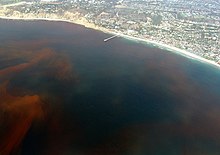User:Sofiagians/sandbox
 | This is a user sandbox of Sofiagians. You can use it for testing or practicing edits. This is not the sandbox where you should draft your assigned article for a dashboard.wikiedu.org course. To find the right sandbox for your assignment, visit your Dashboard course page and follow the Sandbox Draft link for your assigned article in the My Articles section. |
Article evaluation: Gonyaulax
species that is found underwater.
- usually found in marine water, but some are found in fresh water. they create a phenomenon called "red tide."
Structure[edit]

Gonyaulax are a type of dinoflagellates, meaning that they are a type of aquatic organism that have two separate flagella, each having characteristics of both a plant and animal organism. Two separate flagella: one flagella extends backward, and the other flagella helps to keep the organism afloat.
Adaptations[edit]
Gonyaulax species are a form of dinoflagellates, which means they have evolved different mechanisms to survive harsh weather conditions. Resting Cysts can be formed when temperature or salinity changes in the surrounding water. These cysts are round mucous covered bodies that gain a reddish color. This color helps to form the red tide stated previously. Gonyaulax catenella has been recorded forming vegetative cysts in response to cold water.
Reproduction[edit]
Gonyaulax species will reproduce in long chains of protists, especially when faced with turbulent water conditions. These chains allow for clustering of organisms for increased mating, and protection of weak swimming organisms that could otherwise be washed away.
Red Tide[edit]
Red Tide is a discoloration of the sea water that the Gonyaulax species inhabit. These are typically caused by the dinoflagellate genus species. Red tide is a toxic event that can kill any type of underwater creature that happens to come in contact with it. The red tide effect that is caused by the reproduction of many dinoflagellates are some of the most toxic poisons known to date.
Affect on Humans[edit]
Although Gonyaulax is predominately found underwater, it can also have a detrimental effect on humans. If humans eat an amount of seafood (ex: mussels or shellfish), and that sea creature has ingested Gonyaulax catenella, it can poison the individual that eats it.
https://www.britannica.com/science/Gonyaulax[3]
- ^ "Gonyaulax". Encyclopedia Britannica. 2/2/2017.
{{cite web}}: Check date values in:|date=(help) - ^ "Gonyaulax Adaptations". bioweb.uwlax.edu. Retrieved 2017-04-06.
- ^ "Gonyaulax". Encyclopedia Britannica. 2/2/2017.
{{cite web}}: Check date values in:|date=(help)
